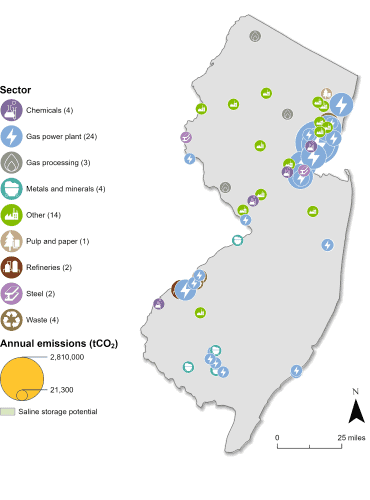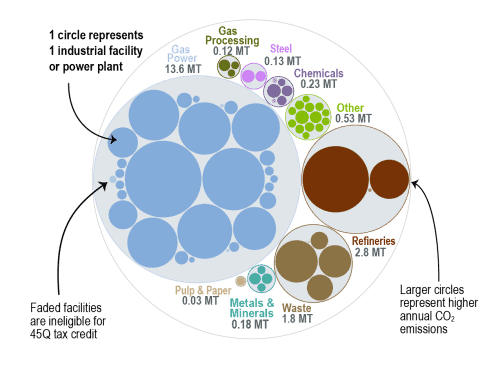New Jersey Carbon Capture Opportunities

Carbon management could play a key role in New Jersey’s emissions reduction efforts and clean energy goals. Of the 81 industrial and power facilities in the state, 58 are eligible for the 45Q federal tax credit. These 58 facilities emit around 19 million metrics tons of carbon dioxide (CO2) annually, representing 99 percent of total annual CO2 emissions in the state. A plurality of these facilities are gas power plants with a total of 24 facilities, representing nearly 70 percent of the state’s total annual CO2 emissions.
Recent legislation introduced in New Jersey indicates that the state recognizes the important role carbon management will play in emissions reduction efforts. However, the state would benefit from introducing and enacting additional legislation to address key issues related to CO2 transport and storage.

Industrial and Power Facilities in New Jersey
New Jersey has 58 facilities that are eligible for the 45Q tax credit. The plurality of these are gas power plants with 24 facilities, which emit 13.5 million metric tons of CO2 annually. New Jersey also has four chemical plants, two steel plants, two refineries, three gas processing plants, and 23 other industrial facilities that are 45Q eligible. In total, these 58 facilities emit approximately 19 million metric tons of CO2 annually, representing 99 percent of the state’s annual CO2 emissions.
New Jersey also has potential for permanent offshore geologic storage. Additionally, the state’s proximity to other Mid-Atlantic states with a heavy industry presence means that New Jersey is well-positioned as a corridor for transporting CO2 regionally.

Sources: EPA GHGRP, 2024. Bauer et al., NATCARB, 2018.
Legislative Context for Carbon Management
Governor Phil Murphy’s Executive Order 315 set a goal of ensuring that 100 percent of energy sold in New Jersey comes from clean sources by 2035. Additionally, recent legislative action indicates that the state recognizes the potential of carbon management technologies in decarbonizing its economy.
New Jersey has several pieces of legislation supportive of carbon management technologies that are moving through the legislative process as of early 2025:
- A4217 supports projects that result in a measurable reduction greenhouse gas emissions (GHGE) through the use of innovative technologies, including carbon capture technology. The bill authorizes the New Jersey Economic Development Authority to provide grants or other financial assistance to commercial, institutional, and industrial entities for projects that may include the development or implementation of carbon capture technology.
- A4493 authorizes public utilities in New Jersey to develop and implement utility innovation plans to reduce GHGE associated with natural gas use, including through the use of carbon capture and utilization technologies.
- A604 establishes the Clean Energy Technology Center within the New Jersey Board of Public Utilities to promote clean energy-related employment opportunities and advance clean energy technology, including carbon capture and storage technologies.
- S2425 and A3645 target a 10 percent reduction in transportation fuel emissions by 2030 (compared to 2019). It requires fuel suppliers to meet carbon intensity limits, using a credit-trading system for compliance. Hydrogen and fuels derived from carbon capture and utilization qualify as alternative fuels under the program.
Recognizing the importance of carbon management in reducing emissions, the state should introduce and enact additional legislation to address key challenges related to CO2 transportation and storage (e.g., long-term liability of Class VI injection wells), ensuring it is better prepared for deployment. To see real time updates on New Jersey’s active legislation, see our State Legislative Tracker.
This bubble diagram shows the number of facilities and corresponding annual CO2 emissions for each industry in New Jersey. The darker large bubbles are eligible for the 45Q carbon capture tax credit, while the faded bubbles are too small to be eligible. The total amount of CO2 emissions in New Jersey is listed for each industry.

Sources: EPA GHGRP, 2024. Bauer et al.
Last updated: February, 2025

